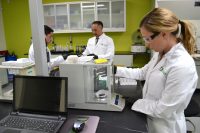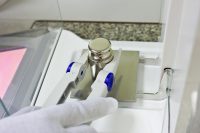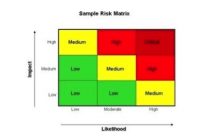The cannabis industry of the United States is unlike other horticulture markets in the country. It’s younger, less traditional and with roots in a black market, it’s no surprise that its forerunners aren’t afraid to experiment with new approaches and technology.
The rapid adoption of IoT (Internet of Things) technology is one way in particular that this new generation of producers is stepping up, and they’re beginning to reap the rewards. But to better demonstrate how significant the implementation of IoT tech can be, we’ll peek over the fence at other craft-oriented food industries—namely wine and chocolate—to discover how effective they can be long-term for serious players in the cannabis industry.
The results, as you can probably guess, are astounding.
Farm Productivity and Precision is on the Rise
IoT tech isn’t just a cool new thing for experimental growers – it’s as necessary as air in the 21st century. New and veteran farms alike are discovering ways to streamline production and enhance the quality of their crops. One of the most common implementations of IoT tech in agriculture is the installation of smart measurement tools. Remote sensors can monitor soil acidity, humidity, salt concentrations, temperature and a variety of other metrics, automating the collection of data and providing a clear picture of plant health. For many farms, like E. & J. Gallo Winery, this is a game-changer.By installing hundreds of sensors per block and upgrading to a more precise irrigation system, Gallo was able to connect moisture measurements to a central system
Before placing sensors in over 250 acres of their vineyard, Gallo could only make irrigation adjustments at the large block level. Even with careful monitoring of moisture levels, the grape yield was inconsistent in size and flavor. By installing hundreds of sensors per block and upgrading to a more precise irrigation system, Gallo was able to connect moisture measurements to a central system. The system collects the data, considers the weather forecast, and automatically irrigates small areas of the vineyard as needed to ensure all plants are optimally watered. This resulted in a more uniform crop, less water waste and more desirable grapes.
Cannabis farms are starting to pick up on this simple approach as well. Organigram, one of Canada’s leading Cannabis producers, is well aware of the benefits of this kind of automation and data collection. “All our grow rooms are helping us learn all the time,” says Matt Rogers, head of production at Organigram. “With 20 grow rooms going, we can gather as much information about these plants as you would get in a century of summers.”
Automation and precision have enabled by Gallo and Organigram to improve yield and increase precision, which has helped them achieve their well-respected status in the wine and cannabis industries.
The Supply Chain is Becoming More Transparent
As much as we would like the industry to be free of scams and crooks, there’s more than a few producers stretching the truth when it comes to labeling product. MyDx, a cannabis chemical analyzer, recently revealed that the label on the package often does not totally coincide with the product within.Protecting your brand’s reputation is a necessity and IoT tech is helping some pioneering industries do that.
For example, the most frequently tested cannabis strain, “Blue Dream”, averages a 64% difference in chemical makeup from sample to sample. Similarly, “Gorilla Glue” and “Green Crack” show as much as 83% variation from sample to sample—largely because there’s no regulation of these names.
While variation is inevitable from grower to grower, plant to plant, and even between different parts of the same plant, misleading labels and the addition of ‘fillers’ is a growing issue for edible cannabis producers, and the threat it poses to your brand isn’t minor. Protecting your brand’s reputation is a necessity and IoT tech is helping some pioneering industries do that.
Wine in China is a powerful example of how improved traceability can reduce large-scale mislabeling. Brand-name winemakers in the country face a massive problem: 70% of imported wines are counterfeits. To combat this, winemakers are attaching near-field communication (NFC) labels to imported and domestic bottles. It’s a dramatic solution, but one that’s protecting the brand of winemakers dedicated to quality and transparency.
As the legalization of cannabis spreads and coveted strains emerge, so will the availability of counterfeits—or, at the very least, less-than-truthful labeling. This has proven to be true in almost every specialty market, and adopting improved traceability tech will defend your brand and reputation from the consequences of selling a product that’s discovered to be more ‘filler’ than cannabis.
Compliance is Easily Achieved
The conversation of cannabis regulation generally revolves around age restrictions and driving while impaired, but government compliance is far more complicated – especially for facilities that create cannabis-infused food products. And here’s the frustrating part for those who must (and should) maintain a food safety plan: every time a regulation is adjusted (or every time a new variation is added in another state), facilities must be able to document changes in procedures, recipes and hazard controls. It gets complicated quickly, especially if all the documentation is kept manually.
There’s a lot to be gained by connecting your systems and products to the Internet of ThingsA central, connected system is the best way for food manufacturers to streamline and automate a variety of documentation and food safety tasks, which can mean thousands of dollars saved over months or years. Using software like Icicle, facilities can create a comprehensive data environment that’s dynamic and accessible from anywhere. Incoming measurements from connected equipment and employee records are collected and an admin dashboard allows you to see what food safety systems are thriving and which need revisiting. The records – transformed into a compliant food safety plan – can then be pulled up during audits and inspections on the spot, saving the months that companies usually spend preparing documentation.
According to Mitchell Pugh of Chewter’s Chocolates, their system “gives me a great peace of mind in the sense to know we have all our information prepared and anything that an inspector is going to ask for – whether they’re looking for one product, a general system, a certain hazard, or a bill of ingredients or materials or an allergen – is easy for us to search for it, pull it up, and find exactly what they’re looking for.”
Considering that most food manufacturers still record measurements and create food safety plans manually, this is an area where progressive companies can quickly outpace their non-automated rivals.
Whether you’re a grower, dispensary, food producer, or some other kind of cannabis professional, there’s a lot to be gained by connecting your systems and products to the Internet of Things. Which direction will you take?

































